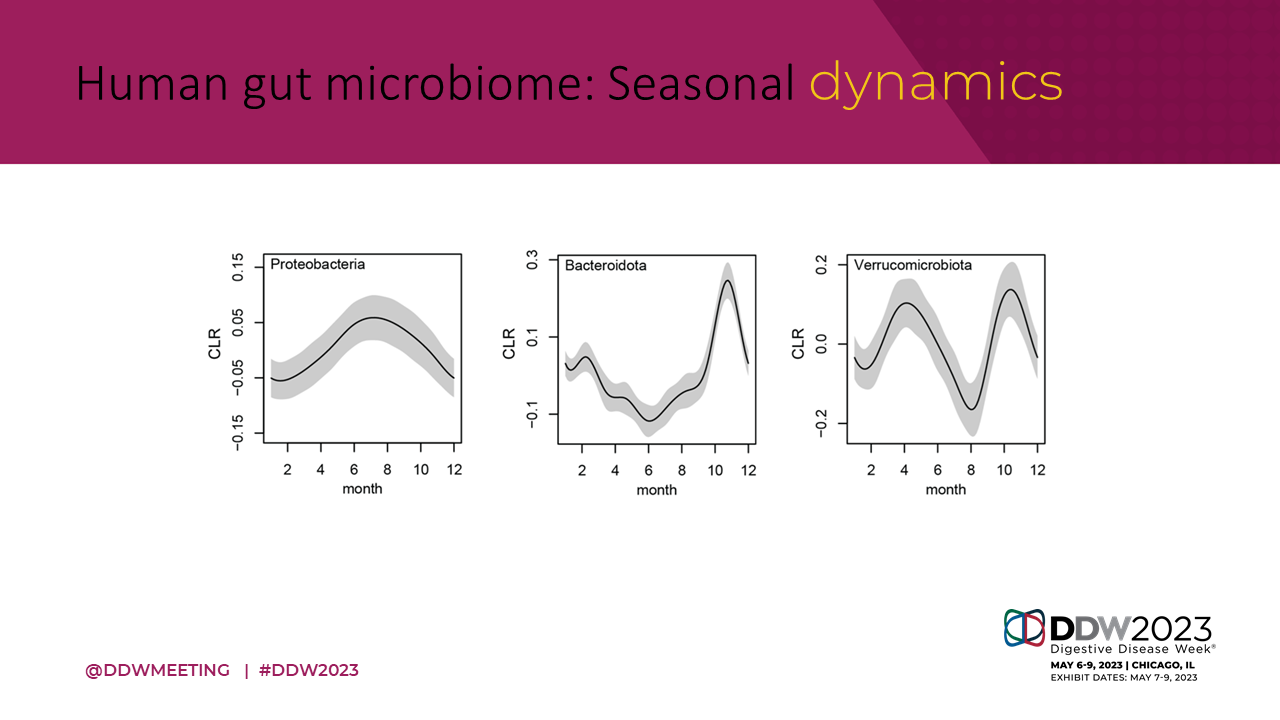
The human gut microbiome is much more dynamic than previously thought, demonstrating daily and seasonal fluctuations, according to new research to be presented at Digestive Disease Week® (DDW) 2023. The findings, based on analysis of around 20,000 stool samples in an international database, are presented by Carolina Dantas Machado, PhD, the study’s lead author and a researcher in the laboratory of Amir Zarrinpar, MD, PhD, at the University of California, San Diego.
“Previous work has demonstrated diurnal microbiome fluctuations in small cohorts around the world,” said Dr. Dantas Machado. “But these were in relatively small or more similar groups of people. We wanted to see if we could see these fluctuations at a population level across different regions.”
Dr. Dantas Machado used data from the American Gut Project, one of the largest databases of microbiome data, to analyze the bacterial makeup of adult stool samples from countries around the world collected mostly between 2013 and 2019. They observed both diurnal and seasonal gut microbiome rhythms at various taxonomic levels.
- 57% of bacterial phyla showed 24-hour cyclicity. For example, Actinobacteriota levels were lower in samples taken in the morning and much higher in samples taken toward the end of the day.
- Seasonal microbiome variations were observed throughout multiple regions of the world. For example, Proteobacteria levels consistently dropped during the winter and steadily increased until peaking during the summer.

“The percentages of bacteria change dramatically,” said Dr. Dantas Machado. “And if the proportions of everything are different, then it’s a different microbiome. We need to understand better how the microbiome affects health and disease in the context of a gut environment that is much more variable and dynamic than we previously thought.”
Throughout the course of the day, bacterial populations could be affected by nutrient and water intake as well as periods of rest and activity. Seasonal fluctuations are more difficult to explain, but changes in light, pollen exposure, humidity and temperature could be potential contributors. Dr. Dantas Machado is currently exploring the impact of latitude on seasonal microbiome fluctuations to help address some of these questions.
It’s still too early to incorporate these findings into actionable advice for clinicians or patients, according to Dr. Zarrinpar, who stressed that researchers must consider these types of fluctuations when conducting microbiome research. Diurnal rhythms may not be apparent in studies with small sample sizes but may still impact study results.
“We find that people have a different microbiome in the morning than we do at night,” said Dr. Zarrinpar. “If you’re conducting a study, and different participants are collecting samples at different times during the day, you need to take into account that the variations in microbiome between populations could simply be a factor of when the samples are collected.”
Ultimately, the researchers hope that work like this can provide new insights into the link between the microbiome and disease. “Many diseases show seasonal variation—allergies, respiratory infections, infectious diarrhea—these all occur seasonally,” said Dr. Zarrinpar. “Our data now suggest that these are all occurring in the context of a different microbiome. Because the microbiome and the immune system are so interrelated, data like these could give us more insight on how the microbiome contributes to disease and health.”
“A better understanding of how the microbiome fluctuates could have tremendous impact on clinical decisions,” said Dr. Dantas Machado. “Bacteria perform so many important functions, such as metabolizing the food we eat as well as certain drugs. The more we understand the microbiome, the more we can understand how to better use it to impact our health and understand the human condition in general.”
Dr. Dantas Machado presents the results of the study, “The human gut microbiome displays diurnal and seasonal rhythmic patterns,” abstract 395, on Sunday, May 7, at 11:20 a.m. CDT as part of the session, “AGA Charles M. Mansbach II, MD, Memorial Lecture — When We Eat: How Much Does It Matter?”
Register to see this session
If you’re not yet registered, secure your spot at DDW 2023 to unlock access to this session. All session captures will be released 24 hours after they’re complete and will be available to all attendees, both in person and online, to watch on demand.





One Response
very very interested,I am in